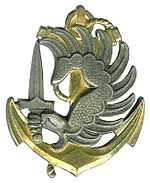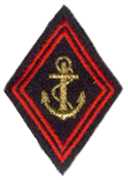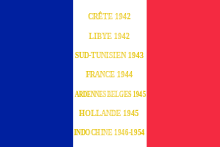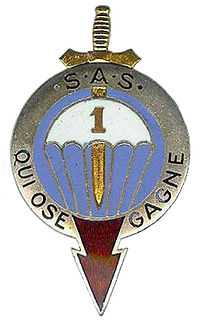1st Marine Infantry Parachute Regiment
| 1er Régiment de Parachutistes d'Infanterie de Marine | |
|---|---|
|
Regimental insigne | |
| Active | 1941– |
| Country | France |
| Branch | Armée de Terre |
| Type | Special Forces |
| Role |
Special Operations Counter Terrorism |
| Size | One regiment |
| Part of | Troupes de marine / Army Special Forces Brigade |
| Garrison/HQ | Bayonne, France |
| Motto | Qui Ose Gagne (Who Dares Wins) |
| Anniversaries | Saint-Michel Day |
| Engagements |
World War II First Indochina War Operation Desert Storm Operation Enduring Freedom Operation Licorne Operation Serval |
| Commanders | |
| Current commander | Colonel Laurentin |
| Insignia | |
| Beret badge of the 1st Marine Infantry Parachute Regiment |
 |
| Abbreviation | 1er RPIMa |
The 1st Marine Infantry Parachute Regiment (French: 1er Régiment de Parachutistes d'Infanterie de Marine, 1er RPIMa) is one of three regiments (1er RPIMa, 13e Régiment de Dragons Parachutistes (13e RDP), 4e RHFS) in the French Army Special Forces Brigade (BFST).
The 1er RPIMa is one of Europe's most experienced special forces units, and has been constantly operationally deployed right from the beginning of its new role over thirty years ago.
It takes advantage of an exceptional location in Bayonne, in South Western France, which enables all sort of training (amphibious, mountain…), and the proximity of dedicated assets of the French Army's 4th Special Forces Helicopter Regiment (4e RHFS) and airborne school (ETAP), two establishments that are essential for its training and operations.
The list of its recent operational deployments indicates a worldwide commitment that ranges from Afghanistan, to Africa and the Balkans. The acknowledged expertise of the Regiment is such that in recent years, many prominent European countries have entrusted it with the evacuation of their nationals in war-torn countries. The trust these countries have has never been misplaced and the 1er RPIMa has safely whisked out of harm's way hundreds of EU and foreign nationals in recent years.
Similarly, from the beginning of its involvement in Operation Enduring Freedom in Afghanistan, first in 2001 and again from 2003 onwards, the Regiment has won high praises. The commitment of its members has been rewarded several times by the American forces in the form of Bronze Stars, Army Commendations and Army Achievement Medals.
The high level of expertise attained by the 1er RPIMa also makes it a highly sought-after partner in the development of Special Forces units abroad and the Regiment constantly receives requests for assistance in that specific field from sister units around the world.
Always the first to be deployed, the 1er RPIMa is at the forefront of France's defence. It is constantly on the lookout for new solutions and opportunities and thereby remains faithful to the motto of its SAS (Special Air Service) ancestors, "Who Dares Wins".
Unit specialization
- CTLO (Counter-terrorism and hostage rescue teams (InvEX))
- GDC (Bodyguards Garde du Corps)
- THP (Snipers Tireurs Haute Précision)
- RCO (Paratrooper – Rapas Chuteurs Opérationnels)
- PRS (motorized patrols Patrouilles de Reconnaissances Speciales(PAT-SAS))
- RPO (Combat divers Rapas Plongeurs Offensifs)
- Mountain/arctic, desert and jungle warfare
- Explosives and demolitions
History
Origins

Despite of its name, the 1er RPIMa does belong to the French Army. The Naval Infantry background dates back to 1762 when units of the French Army were detached to the French navy for ship borne and overseas duties.
- The World War II forebears
The 1er RPIMa inherited the traditions of the two Free French Special Air Service (SAS) Regiments that served with distinction alongside their British brothers-in-arms of the SAS Brigade during World War II.
On September 15, 1940, General Charles de Gaulle signed the activation order of the 1ère compagnie d'infanterie de l'air des forces françaises libres (1ère CIA) or 1st Free French Airborne Infantry Company under the command of Captain Bergé.
The 1ère CIA started carrying out operational missions by parachute insertion into occupied France in March 1941. The company was then split into two components, a covert action unit used in clandestine operations and a conventional and uniformed company that was sent to North Africa in September 1941 to fight the Axis Forces with the British Forces.
A very good relationship was quickly established between Captain Bergé and Major Stirling, the commander of the newly created Special Air Service (SAS); the French detachment was soon incorporated into the SAS and became the French Squadron. From 1942 to 1943, the French SAS roamed the region, ranging as far as Crete hunting down Axis forces and destroying their aircraft and supply dumps.
In November 1943, the 3ème and 4ème Bataillons d'Infanterie de l'Air were created and incorporated in the SAS Brigade with their British and Belgian counterparts of the 1st and 2nd SAS Regiments.
The Free French SAS took an important part in the liberation of Europe. In Brittany, a little after midnight on D-Day June 6, 1944, Caporal Emile Bouétard (born in Brittany, 1915) was the first killed in action in Plumelec, Morbihan. On August 1, 1944, the 3ème and 4ème Bataillons d'Infanterie de l'Air were renamed 2ème and 3ème Régiments de Chasseurs Parachutistes. As a reward for their bravery, King George VI, awarded the Free French SAS the red beret of the British SAS which replaced the black beret worn until then. As the war drew to a close, 52 French SAS "sticks" (705 men) were parachuted over the Netherlands on April 7, 1945, causing major havoc in the rear areas of German occupation forces and easing pressure on the forward thrust of the 2nd Canadian Army Corps.
On May 8, 1945, the Free French SAS could look back with pride at their achievements. They had been amongst the very first to join Sir David Stirling in North Africa and had taken a major part in the epic battles of the SAS in Africa, France, Belgium, the Netherlands and Germany, earning French and foreign awards in so doing (including many British DSOs, MCs and MMs). The regimental colours of the 1er RPIMa have also been decorated with the US Bronze Star Medal, the Dutch Bronzen Leeuw and the Belgian Croix de Guerre. Today, this SAS heritage is still evident through its regimental motto "Qui Ose Gagne" ("Who Dares Wins") and in the awarding of the RAPAS Wings, reminiscent of the wartime SAS "Operational Wings" that can only be awarded to 1er RPIMa operators after they have successfully passed a series of strict selection requirements, including operational deployments.
- 1945-1974
Between 1945 and 1954 the unit that was later to become the 1er RPIMa after a series of name changes, took part in the war in Indochina, performing several of the more than 160 combat jumps carried out by French paratroopers during that conflict. After the war, the regiment underwent structural changes and became a training depot for the entire colonial airborne forces. As such, it did not take part in the Algerian conflict. It remained in the training role until 1974 when the 1er RPIMa was transformed into a Special Forces unit, a role it still has today.
- 1974-2006
Its mission has been mostly to support France's interests in Africa between 1974 and 1981, the 1er RPIMa underwent another mission change, it then focused on Long Range Reconnaissance Patrols for almost a decade, while it still used its training skills training friendly forces abroad.
The 80s and 90s were busy years for the regiment; these were the days when it deployed dozens of times to various hotspots on the planet. While engaged in Operation Desert Storm, the 1er RPIMa lost two of its men in Iraq in 1991.
A year later, the creation of the French Special Operations Command (Commandement des Opérations Spéciales, COS) led to a major shake-up of French special forces units in order to incorporate what had been learned in the First Gulf War. As part of this process, in 1997, the nucleus of what was to become the army's BSFT (Brigade des Forces Spéciales Terre) (Special Forces Brigade Land) was created and the 1er RPIMa became its core unit. All the while, the regiment participated in operations in the Balkans and in Africa; it was specifically involved in stalking war criminals in Bosnia, leading to several successful arrests of individuals indicted for war crimes.
Today

Part of the French Army Special Forces Brigade (BFST), the 1er RPIMa is a modern, highly skilled and experienced Special Forces unit organized along company lines. The main strength of the regiment lies in its three RAPAS companies (RAPAS meaning Airborne Reconnaissance and Special Action) each specialised in a specific field such as HAHO/HALO, Counter-Terrorism, amphibious, jungle, mountain or motorized patrols operations and its RAPAS Signal company dedicated to the C3 (Command, Control and Communications) support of Special Operations.
The 1er RPIMa also fields a Training and Operations company tasked with providing selection, basic and continuation training of the unit's manpower and a Logistics company which supports the regiment in its daily and operational missions.
Organisation and structure
Due to its long history with the British Special Air Service much of the 1er RPIMa core aspects are based upon the British SAS. Each company specialises in a particular area such as maritime, air and parachuting operations, mobility.
- Four main RAPAS combat companies:
- 1e Compagnie (Paratroopers HAHO, HALO / Combat divers/ Urban warfare, counter-terrorism and bodyguards)
- 2e Compagnie (Mountain, arctic, desert and jungle warfare)
- 3e Compagnie (Motorized patrols)
- 4e Compagnie (Recon, acquisition, training)
There is also one Command and Logistics Company.
Skills
The 1er RPIMa relies on a number of skills to successfully carry out its missions. Most skills are either regiment or brigade-specific and need constant honing to be kept at the desired level of proficiency. They can be divided into several generic fields:
- The RAPAS (Airborne Reconnaissance and Special Action) basic skills
- The RAPAS skills are given to Enlisted men and NCOs after they have completed a series of organic and basic regimental courses - Basic training leading to the first rung of the RAPAS ladder is the elementary RAPAS technical certificate which is 6 months long. - RAPAS training covers all the basics of the SF operator's functions. It is then complemented by specific courses (DZ and LZ marking, basic and advanced CQB, sniping…) - A RAPAS group is led by a senior NCO or a Lieutenant. NCOs are generally former enlisted men who have risen from the ranks of the regiment while officers come from various specialised schools (mostly Infantry, Armour and Engineer) before following a specific course complemented by on job training within the groups. - When fully qualified and operational, a RAPAS team member has reached the rank of Caporal-chef (Master Corporal), and has been in the regiment for five years and spent more than two thirds of his time in the regiment following courses and has been deployed on real-world operations probably once a year.
- Air insertion
- Parachute operations: each member of the regiment is static-line parachute qualified using some specific low-altitude (125 metres) dropping techniques. The 1er RPIMa can also field different teams proficient in both HAHO and HALO techniques. Each company has a HALO capability.
- Helicopter operations: Fast-roping and helicopter rappelling, special purpose infiltration and extraction rigs, LZ marking, special operation procedures, helicopter fire support, helicopter-borne sniper support, light helicopter insertion and extraction
- Air delivery: the 1er RPIMa is unique in the way it has integrated air delivery component with teams able to rig and airdrop light to heavy loads and pallets in support of special operations from cargo aircraft of dedicated special operations division of the French air force.
- Amphibious operations
- Open circuit breathing apparatus: the 1er RPIMa can field a complete open air circuit (scuba) team for beach recce or riverine operations using light crafts, including kayaks
- Closed circuit breathing apparatus: the 1er RPIMa can field a complete closed circuit team for covert underwater missions. This team is not a combat diver team; its purpose is to use waterways as another infiltration method.
- Motorised operations
- True to their SAS ancestors, the 1er RPIMa has always maintained a motorized patrol capability. It currently centres on PATSAS patrols that are tasked with developing and refining the methods and equipment needed for such operations. In addition to the PATSAS, each RAPAS company fields several motorised RAPAS groups. The mounts of motorised patrols are modified Peugeot P4s, Mercedes VPS and ACMAT VLRA trucks, all fitted with machine guns, automatic cannons, mortars, AGLs or ATGWs.
- The Special Recce Patrols (PRS)
- Having understood with time and experience that it is always better to act on intelligence which had been gathered and analysed by operators that intimately know which method of operation would be best used by the action groups, the 1er RPIMa has decided to include in its specialized teams the PRS concept. - The PRS are infiltrated ahead of the action teams and provide real time intelligence on the target area. The information gathered by the PRS is then transmitted by a variety of secure means to the command level which then disseminates it to the action groups.
- Counter Terrorism
- The 1er RPIMa can field several CT teams, all backed by specialized sniper teams proficient in calibre's ranging from 5.56 mm to 12.7 mm (.50 cal) - All ranks of the company are CT trained - The Regiment benefits from proximity to the Centre d'Entraînement Adapté (CTA), Europe's largest and most modern CQB facility (CQB = Close Quarters Battle or Killing House). The CTA is located in Pau and offers unmatched live firing capabilities for all sorts of CT scenarios. - The CQB skills are kept honed to a high level thanks to regular training in the CTA and cross training with French and Allied CT units.
- Bodyguard teams
- The 1er RPIMa has been involved in bodyguard duties for the last 25 years.
- The Regiment only provides Bodyguard teams to high-ranking officials at theatre level. - A fully qualified RAPAS team member is also Bodyguard qualified
- Jungle, desert and mountain operations
- So as to prepare RAPAS units of the 1er RPIMa for operations over difficult terrain it can use French and foreign training centres on the world
- Mountain, jungle and desert training exercises are scheduled every year - RAPAS team members are sent regularly as permanent instructors to jungle and desert schools in French Guyana or friendly African countries - Every year, the Regiment sends some of its members to foreign schools to improve its tactics and procedures in hostile environments (jungle, bush…) - A regular influx of experienced NCOs volunteering from the French 27th Mountain Infantry Brigade keeps the Regiment up-to-date on modern mountaineering techniques
Selection and training
Officers and NCOs joining the regiment have to attend the same selection and training as enlisted personnel.
Enlisted soldiers in the French Army can try to join 1er RPIMA, between their first and third years of active duty.
First step is a profile selection: Candidates will be selected regarding unit requirements and personal file (e.g. if the regiment needs some mountain specialists, they will ask for more mountain troopers to come for the selection). Candidates selected must attend the two weeks basic airborne training prior the SF training, for those who are not already enlisted in an airborne regiment.
Second step of selection is "adaptation training" and "stage commando" lasting twelve weeks. Candidates must be above average to continue the training. Most cases of failure and RTU occur during this phase.
The last step of selection is the "stage CTE RAPAS" lasting six months. After completion of this "stage", candidates are fully assigned to the regiment as special force soldier. They will attend additional training to become specialists (bodyguards, pathfinders, etc.)
Similar units
-
 Albania – Special Operations Battalion (Albania)
Albania – Special Operations Battalion (Albania) -
.svg.png) Belgium – Special Forces Group (Belgium)Special Forces Group
Belgium – Special Forces Group (Belgium)Special Forces Group -
 United Kingdom – Special Air Service
United Kingdom – Special Air Service -
 Finland – Special Jaegers
Finland – Special Jaegers -
 Ireland - Army Ranger Wing
Ireland - Army Ranger Wing -
 Russia – Vympel
Russia – Vympel -
 Italy - Col Moschin
Italy - Col Moschin -
 Canada – Joint Task Force 2
Canada – Joint Task Force 2 -
 United States – SFOD
United States – SFOD -
 Poland – GROM
Poland – GROM -
 Russia – Alpha Group
Russia – Alpha Group -
 Sweden – Special Operations Group
Sweden – Special Operations Group -
 Germany – Kommando Spezialkräfte
Germany – Kommando Spezialkräfte -
 South Korea – 707th Special Mission Battalion
South Korea – 707th Special Mission Battalion -
 Denmark - Huntsmen Corps (Denmark)
Denmark - Huntsmen Corps (Denmark)  Pakistan - Special Service Group
Pakistan - Special Service Group Norway - Hærens Jegerkommando
Norway - Hærens Jegerkommando
Parent unit
- Army Special Forces Brigade
Battle honours

- Crete 1942
- Libye 1942
- Sud Tunisien 1943
- France 1944
- Ardennes Belges 1945
- Hollande 1945
- Indochine 1946-1954
- 2011 Libyan civil war
Decorations
- Cross of the Légion d'honneur
- Cross of the Libération
- Croix de guerre 1939-1945 with 6 palms
- Croix de guerre des Théatres d'Opérations Exterieures with 3 palms
- Croix de guerre (Belgium)
- Bronze Star (USA)
- Bronze Lion (Netherlands)
References
- Shortt, James (1981). The Special Air Service. Oxford: Osprey Publishing. ISBN 0-85045-396-8.
External links
- 1er RPIMa Official website
- QUI OSE GAGNE: Association des Anciens Parachutistes Troupe de Marine et anciens de la Brigade des Parachutistes Coloniaux héritiers des S.A.S
- QUI OSE GAGNE: Association des Anciens Parachutistes Troupe de Marine et anciens de la Brigade des Parachutistes Coloniaux héritiers des S.A.S
- QUI OSE GAGNE: Association des Anciens Parachutistes Troupe de Marine
et anciens de la Brigade des Parachutistes Coloniaux héritiers des S.A.S


